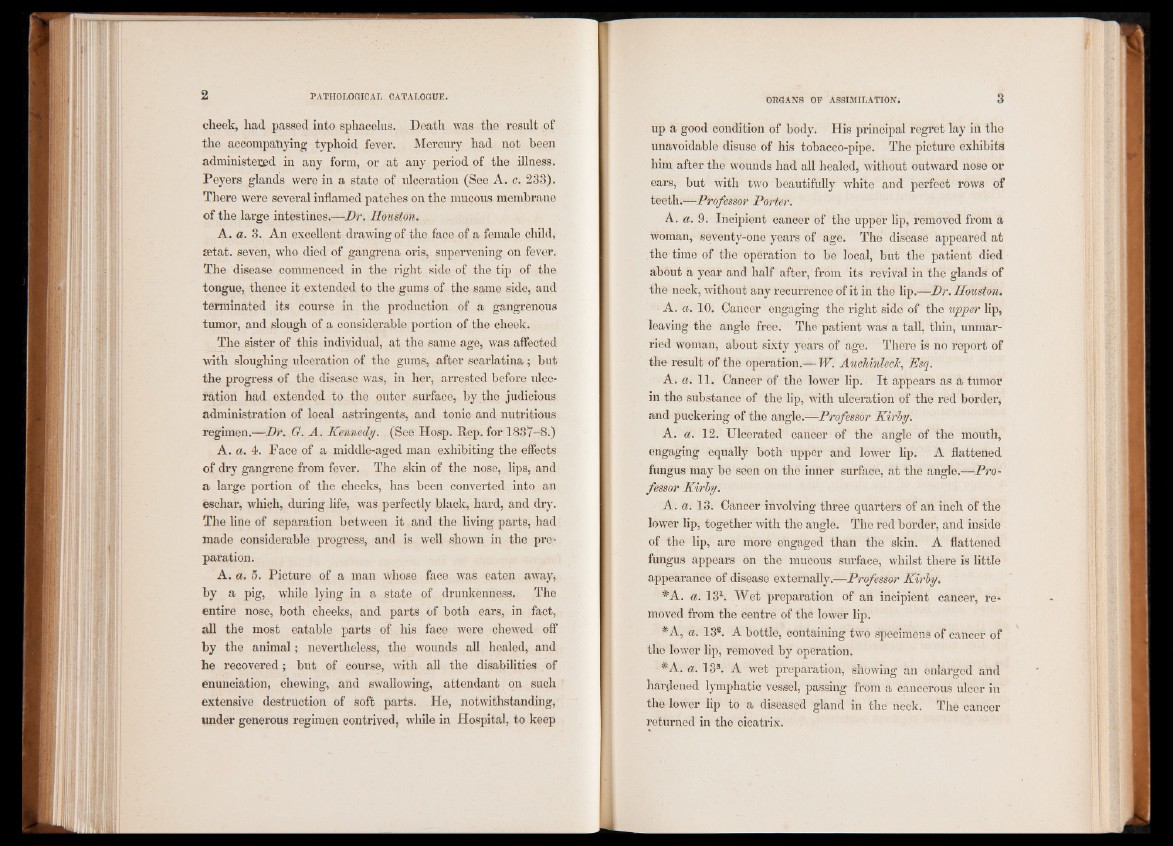
cheek, had passed into sphacelus. Death was the result of
the accompanying typhoid fever. Mercury had not been
administered in any form, or at any period of the illness.
Peyers glands were in a state of idceration (See A. c. 233).
There were several inflamed patches on the mucous membrane
of the large intestines.—Z>r. Houston.
A. a. 3. An excellent drawing of the face of a female child,
setat. seven, who died of gangrena oris, supervening on fever.
The disease commenced in the right side of the tip of the
tongue, thence it extended to the gums of the same side, and
terminated its course in the production of a gangrenous
tumor, and slough of a considerable portion of the cheek.
The sister of this individual, at the same age, was affected
with sloughing ulceration of the gums, after scarlatina; but
the progress of the disease was, in her, arrested before ulceration
had extended to the outer surface, by the judicious
administration of local astringents, and tonic and nutritious
regimen.—Dr. G. A. Kennedy. (See Hosp. Rep. for 1837-8.)
A. a. 4. Face of a middle-aged man exhibiting the effects
of dry gangrene from fever. The skin of the nose, lips, and
a large portion of the cheeks, has been converted into an
eschar, which, during life, was perfectly black, hard, and dry.
The line of separation between it and the living parts, had
made considerable progress, and is well shown in the preparation.
A. a. 5. Picture of a man whose face was eaten away,
by a pig, while lying in a state of drunkenness. The
entire nose, both cheeks, and parts of both ears, in fact,
all the most eatable parts of his face were chewed off
by the animal; nevertheless, the wounds all healed, and
he recovered; but of course, with all the disabilities of
enunciation, chewing, and swallowing, attendant on such
extensive destruction of soft parts. He, notwithstanding,
under generous regimen contrived, while in Hospital, to keep
up a good condition of body. His principal regret lay in the
unavoidable disuse of his tobacco-pipe. The picture exhibits
him after the wounds had all healed, without outward nose or
ears, but with two beautifully white and perfect rows of
teeth.—Professor Porter.
A. a. 9. Incipient cancer of the upper lip, removed from a
woman, seventy-one years of age. The disease appeared at
the time of the operation to be local, but the patient died
about a year and half after, from its revival in the glands of
the neck, without any recurrence of it in the lip.—Dr. Houston.
A. a. 10 . Cancer engaging the right side of the upper lip,
leaving the angle free. The patient was a tall, thin, unmarried
woman, about sixty years of age. There is no report of
the result of the operation.— W. AuchinlecJc, Esq.
A. a. 11. Cancer of the lower lip. It appears as a tumor
in the substance of the lip, with ulceration of the red border,
and puckering of the angle.—Professor Kirby.
A. a. 12 . Ulcerated cancer of the angle of the mouth,
engaging equally both upper and lower lip. A flattened
fungus may be seen on the inner surface, at the angle.—Professor
Kirby.
A. a. 13. Cancer involving three quarters of an inch of the
lower lip, together with the angle. The red border, and inside
of the lip, are more engaged than the skin. A flattened
fungus appears on the mucous surface, whilst there is little
appearance of disease externally.—Professor Kirby.
*A. a. 131. Wet preparation of an incipient cancer, removed
from the centre of the lower lip.
#A, a. 13*. A bottle, containing two specimens of cancer of
the lower lip, removed by operation.
#A. a. 13s. A wet preparation, showing an enlarged and
hardened lymphatic vessel, passing from a cancerous ulcer in
the lower lip to a diseased gland in the neck. The cancer
returned in the cicatrix.